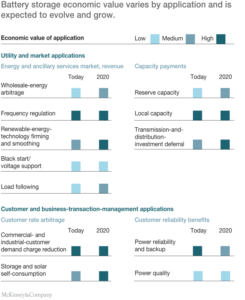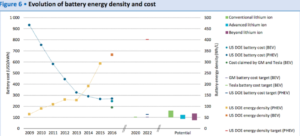Our global economy is connected through the energy industry. For centuries, nations and firms have fought over and sought the right to acquire “black gold” – oil [Yergin]. However, the production and use of these natural resources emits dangerous carbon into the atmosphere, endangering our planet. These carbon emissions result in a changing climate — through higher temperatures, more heat, and stronger natural disasters such as tropical storms and wildfires. In acknowledging the perilous effects of climate change, the world’s fifth-largest economy – the state of California – is embarking on a goal to transition out of a state of affairs governed by the dominant energy sources (oil, petroleum, natural gas) and towards complete utility of carbon-free clean electricity by 2045.
Signed into law in September by Governor Jerry Brown, the bill sets increasingly greater targets on California’s renewable energy capability, with 50 percent by 2026, 60 percent by 2030, and one hundred percent clean electricity by 2045. California represents the second state to set this goal [Ige, 1]. Many are skeptical of the ability of the state to fully transition to clean electricity by the time 2045 rolls around, or are perturbed by possible high costs of energy bills caused by the transition. These being legitimate causes for concern, there are myriad reasons Californians could accomplish this challenging aspiration. The development of battery storage will play a vital role and its economic viability will determine California’s success at this effort. As Fareed Zakaria writes, “We need to store the energy [produced] for when the sun isn’t shining and the wind isn’t blowing. For that we need battery power on a different scale than we have today.”
As has often been the case in its innovative history, California’s investment and pledge to transition entirely to clean electricity sets an important example for the rest of the world to follow and should help influence the private sector to act. Explains the energy expert Daniel Yergin: “High energy prices, climate change and energy security are converging as the new engine driving the development of clean energy … They are being bolstered by public policy…” [Yergin, 1].
The state has crafted policies that incentivize companies and utilities to spend on enhancing renewable energy strategies and investment in energy storage, which is seen as vital towards reaching the one hundred percent clean energy goal. Although currently natural gas power plants currently makes up a large quantity of California’s energy, the state’s leadership and many companies forecast that declining costs of energy storage will ensure that electricity is much more strongly stored. Following his signature on the one hundred percent clean energy bill, Gov. Jerry Brown recently signed another law that allows the state to allocate “an additional $800 million for energy storage to capture electricity generated by solar panels during daylight hours to help keep the lights on after the sun goes down” [Penn, 1]. This money goes into the state’s Self-Generation Incentive Program, which incentivizes providing support for “distributed energy resources” and “rebates for qualifying distributed energy systems installed on the customer’s side of the utility meter” [CPUC, 1]. Through this initiative, California is essentially creating a market for the utilities to research ways to develop new advanced energy storage systems. The state has increased the program’s funding to over $1 billion. The rebate money is available for energy storage and can be used for residential and commercial systems, including for schools, farms and businesses.
Vox’s energy and climate writer, David Roberts argues that it is imperative to get these new markets right, for they are “better at determining the proper amount and location of storage than” politicians. The state should help furnish “a market that values carbon, capacity, ramping, voltage regulation, and all the other services storage can provide, lower barriers to entry, set up transparent rules, and let profit-seeking companies battle it out” [Roberts, 1].
In many sectors, need drives innovation. California is hoping that its regulation of carbon-emitted energies drives private sector innovation vis-à-vis energy storage and new energy markets. This is especially the case for solar generation and capture, smart meters and smart grids that can store and send out energy when necessary.
“For utilities invested in the right analytics capabilities [in smart meters and the smart grid], they enable data-based analyses, planning, and diagnostics. Smart grids are more efficient and less capital intense, allowing for predictive maintenance and better asset health” [McKinsey, 3].
For example, with smarter grids and meters, the potential for energy arbitrage – storing/selling energy during higher-power times during the day and releasing/buying it during less-peak times – will grow. More powerful sensors, smart grids and energy storage provide new opportunities to develop tailored programs for consumers, which will help them control energy usage, heating, and cooling more sufficiently. This is what California is counting on. According to McKinsey & Co. research, there are a number of energy markets that – through improvements in battery storage – will grow significantly in economic value:
Source: McKinsey & Company research, June 2017
Ultimately, “the industry wants dynamic pricing and hourly rates so that solar-plus-storage owners can respond in real time to the real needs of the grid,” Brad Heavner, California Solar and Storage Association policy director, vouches. With new and more efficient batteries, solar energy can be stored by consumers and offers alternatives to carbon emitting energies.
Southern California Edison (SCE), Pacific Gas and Electric (PG&E) and San Diego Gas and Electric (SDG&E) are the three major California utilities. Despite possible rising energy bills due to these initiatives, an indicator of progress is that the economics of energy storage are becoming more cost-friendly every year. This should be a positive trend for the utilities, who could improve services by “incorporating new distributed energy alternatives”, and consumers alike [McKinsey, 2]. The International Energy Agency reported in 2017 that battery costs have declined significantly every year since 2009 and that, concurrently, battery energy storage is enlarging yearly.
Source: International Energy Agency report, 2017
Moreover, Bain & Company partners Julian Critchlow and Aaron Denman – head of and partner in the firm’s Global Utilities practice – come to the conclusion that “large-scale energy battery storage is reaching an inflection point, advancing from limited experimentation to wide adoption” [Critchlow and Denman, 1]. This inflection point is a necessary incubation for California to accomplish its goals. For utilities, grid-connected batteries and battery storage are integral for “managing peak loads, regulating voltage and frequency, ensuring reliability from renewable generation and creating a more flexible transmission and distribution system” [2]. With California-based energy storage systems working with commercial clients, utilities, and governments and using machine-learning and deep learning to “optimize power generation,” Bain determines that immediate benefits should be seen and additional value will be realized over time.
Winston Churchill once remarked regarding oil that “on no one process … or field must we be dependent” [British Parliament Speech, 1913]. Similarly, today we cannot depend on “one process” of gaining energy — society must aim to discover and utilize more efficient, environmentally-friendly energy tactics. Battery storage will be pivotal in this effort. As battery power and costs rise and fall, respectively, California’s ambitious endeavor to use completely clean electricity should be emulated, and if achieved represent a realistic, necessary path forward on energy policy for the world within a changing climate.
Sources:
Beatty, Jack. “A Capital Life: A biography of John D. Rockefeller traces his rise from threadbare country boy to Standard Oil magnate.” The New York Times, The New York Times, 17 May 1998, www.movies2.nytimes.com/books/98/05/17/reviews/980517.17beattyt.html.
Berke, Jeremy. “There’s New Evidence That Fossil Fuels Are Getting Crushed in the Ongoing Energy Battle against Renewables.” Business Insider, Business Insider, 9 Apr. 2018, www.businessinsider.com/solar-growth-outpaces-coal-oil-fossil-fuels-2018-4.
Critchlow, Julian, and Aaron Denman. “Embracing the Next Energy Revolution: Electricity Storage.” Bain Insights, Bain & Company, 31 Aug. 2018, www.bain.com/insights/embracing-the-next-energy-revolution-electricity-storage/.
Garner, Dwight. “’The Quest,’ by Daniel Yergin – Review.” The New York Times, The New York Times, 20 Sept. 2011, www.nytimes.com/2011/09/21/books/the-quest-by-daniel-yergin-review.html.
Genier, Bethany. “Yergin: Renewables Moving Toward Competitive Role in Energy Markets.” Yergin: Renewables Moving Toward Competitive Role in Energy Markets | IHS Online Newsroom, 5 Mar. 2008, https://news.ihsmarkit.com/press-release/energy/yergin-renewables-moving-toward-competitive-role-energy-markets
Gilbert, Ben. “’It’s the Dumbest Experiment in Human History’: Elon Musk Rails against Fossil Fuel Use and Climate Change.” Business Insider, Business Insider, 8 Sept. 2018, www.businessinsider.com/elon-musk-dumbest-experiment-2018-9.
Government, U.S. “U.S. Energy Information Administration – EIA – Independent Statistics and Analysis.” California – State Energy Profile Analysis – U.S. Energy Information Administration (EIA), https://www.eia.gov/state/analysis.php?sid=CA
Ige, David. “David Y. Ige.” David Y. Ige | PRESS RELEASE: Governor Ige Signs Bill Setting 100 Percent Renewable Energy Goal in Power Sector, 8 June 2015, governor.hawaii.gov/newsroom/press-release-governor-ige-signs-bill-setting-100-percent-renewable-energy-goal-in-power-sector/.
International Energy Agency. “Global EV Outlook 2017.” International Energy Agency, IEA, June 2017, https://www.iea.org/publications/freepublications/publication/GlobalEVOutlook2017.pdf
Nikolewski, Rob. “Can California Really Hit a 100% Renewable Energy Target?” Sandiegouniontribune.com, San Diego Union Tribune, 19 June 2017, www.sandiegouniontribune.com/business/energy-green/sd-fi-california-100percent-20170601-story.html.
Penn, Ivan. “California Lawmakers Set Goal for Carbon-Free Energy by 2045.” The New York Times, The New York Times, 29 Aug. 2018, www.nytimes.com/2018/08/28/business/energy-environment/california-clean-energy.html.
Roberts, David. “California Just Adopted Its Boldest Energy Target Yet: 100% Clean Electricity.” Vox, Vox Media, 10 Sept. 2018, www.vox.com/energy-and-environment/2018/8/31/17799094/california-100-percent-clean-energy-target-brown-de-leon.
Santos, Paulo. “On The Tesla Model 3 Being The Safest Car.” Seeking Alpha, 12 Oct. 2018, seekingalpha.com/article/4211218-tesla-model-3-safest-car.
The Parliamentary Debates (official Report).: House of Commons. By Great Britain. Parliament. House of Commons
Yergin, Daniel. The Prize: the Epic Quest for Oil, Money & Power: with a New Epilogue. Free Press, 2009.
Yergin, Daniel. The Quest: Energy, Security and the Remaking of the Modern World. Penguin Press, 2012.
http://faculty.haas.berkeley.edu/wolfram/papers/aea%20dynamic%20pricing.pdf
https://www.nytimes.com/2011/09/25/books/review/the-quest-by-daniel-yergin-book-review.html
https://sites.hks.harvard.edu/fs/whogan/PES_paper_09_salles_final.pdf
https://www.sciencedirect.com/science/article/pii/S0301421506003545


Leave a Reply
You must be logged in to post a comment.